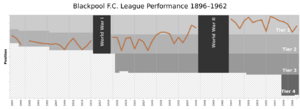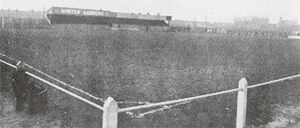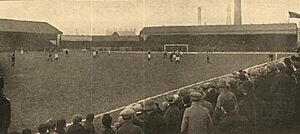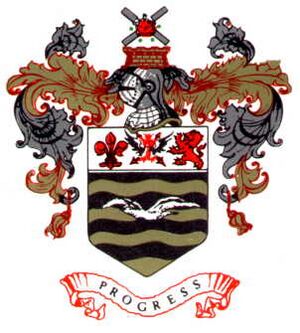History of Blackpool F.C. (1887–1962) facts for kids
The history of Blackpool Football Club from 1887 to 1962 tells the exciting story of the club's early days. It covers how they started, their journey to join the Football League, and their climb to the top division of English football. Blackpool also played in three FA Cup Finals during this time, winning the famous trophy in 1953. That same year, four Blackpool players even played for the England team in a game against Hungary.
Between 1903 and 1962, Blackpool had nine different managers. The most famous was Joe Smith, who managed the team for 23 years! Before 1903, the club's board decided which players would play.
Contents
How Blackpool FC Began
Blackpool Football Club was formed on 26 July 1887. It started when a group of players left another local team called St. John's F.C. Five members, including Revd. N.S. Jeffrey and Sam Bancroft, wanted a football club named after the town of Blackpool.
They disagreed with the other St. John's members and left their meeting. They went next door to the Stanley Arms Hotel and immediately started Blackpool Football Club. Soon, most of the St. John's players joined the new club, and St. John's F.C. stopped existing.
Blackpool F.C. played their first competitive game against Chorley at Dole Lane, winning 2–1. Hargreaves scored Blackpool's first-ever goal.
In their first season (1887–88), Blackpool won two local cups: the Fylde Cup and the Lancashire Junior Cup. In the Lancashire Junior Cup final, they beat Preston St. Joseph's 2–1 with a late goal from T. Parr.
At the end of that season, the club announced a small profit of about £20. Blackpool played their home games at Raikes Hall, a big entertainment complex. This helped them attract around 2,000 fans per game, making the club financially successful in its early years.
Blackpool then became a founding member of the Lancashire League in 1889. They finished fifth in their first season. Over the next three seasons, they were runners-up twice, showing they were a strong team.
In 1891, Blackpool played their first international game against a touring Canadian team at Raikes Hall.
Blackpool first played in the main FA Cup competition in 1891–92, losing to Sheffield United. They lost to the same team again the next season.
In 1893, there was talk of merging Blackpool with another local club, South Shore. Even though both clubs' leaders liked the idea, South Shore members decided to stay independent. The merger finally happened six years later.
In 1893–94, Blackpool won the Lancashire League title. After struggling a bit in the next season, the club decided to aim higher. On 13 May 1896, they became a limited company and applied to join the Football League. Their first attempt failed, but their second try was successful!
Blackpool's third FA Cup game in 1896 was more successful. They beat Burton Swifts but were knocked out by Bolton Wanderers in the next round.
Joining and Leaving the Football League
Blackpool successfully joined the Football League in 1896. For their first season (1896–97), they were part of the Second Division.
Their first-ever Football League game was on 5 September 1896, against Lincoln City. The journey was long and difficult, taking six hours for the team to travel 150 miles! Blackpool lost the game 3–1, but Charlie Mount scored their first-ever League goal from a free-kick.
The club finished eighth in their first League season and attracted many fans to Raikes Hall. However, a year later, they announced a big financial loss. Player wages were very high, and attendance numbers started to drop.
Blackpool's performance on the field also got worse. They finished eleventh in 1897–98 and moved to a new home, the Athletic Grounds. By 1898–99, they finished sixteenth and, along with Darwen, failed to stay in the League. They were replaced by Middlesbrough and Chesterfield.
During this tough time, Frank Wilson, a young player, sadly passed away at 22.
In 1899, while back in the Lancashire League, Blackpool decided to merge with their local rivals, South Shore F.C. The idea was that one strong club would be better than two. After the merger on 12 December 1899, most of South Shore's players joined Blackpool. Blackpool also moved to South Shore's home ground, Bloomfield Road.
Blackpool only spent one season out of the Football League, finishing third in the Lancashire League. In May 1900, they successfully rejoined Division Two.
The club worked hard to rebuild the team. They signed new players like Joe Dorrington (a goalkeeper), Harold Hardman, and Jack Parkinson, who had been their top scorer before. They also sold Jack Cox to Liverpool for £150.
Early 1900s: Finding Their Feet
In their first season back in the League (1900–01), Blackpool finished twelfth, despite a record 10–1 defeat against Small Heath. The referee even had to bring the players back out to play the last four minutes after mistakenly ending the game early!
Blackpool started the 1901–02 season at Gamble's Field, which was soon renamed Bloomfield Road. They finished thirteenth. The club relied heavily on ticket sales and generous committee members to survive financially.
In 1903, Tom Barcroft became the club's secretary, a role he held for over thirty years. He helped stabilize the club during its early years.
Between 1902 and 1905, Blackpool didn't have much success in the League, finishing in the lower half of the table. However, attendances increased, with as many as 7,000 fans coming to watch games.
In 1905–06, Blackpool reached the first round of the FA Cup. They beat Crystal Palace and then faced the strong Sheffield United. To earn more money, the club decided to play the game at Sheffield United's ground, Bramall Lane. Despite protests from fans, Blackpool won 2–1 and earned about £300 from the game.
That season, Blackpool also faced trouble for crowd behavior after a home game against West Brom. The referee had to be escorted off the field by police because of angry fans. The club was warned by the Football League to prevent such incidents.
In 1907, Blackpool again sold the rights to an FA Cup game, this time against West Ham at Upton Park. They earned £300 but lost the match.
The 1907–08 season saw a new board promising more money for players. However, injuries hurt the team, and they finished in the lower half of the table again.
In 1909, Blackpool finished last in the League but successfully applied to stay in the division. Jack Cox returned to the club in 1909–10 as an unofficial player-manager, and the team's performance improved, finishing in mid-table.
Financial problems continued, forcing the club to sell the rights to another FA Cup game against Manchester United at Old Trafford. Blackpool earned £680 but lost the match.
The 1910–11 season was much better, with Blackpool finishing seventh, their most successful season yet. However, the next two seasons saw them return to the bottom of the table, requiring them to apply for re-election again, which they secured.
In 1913–14, Blackpool finished sixteenth. A surprising early FA Cup exit came against Gillingham, a team from a lower league. One important signing that season was Joe Lane, who cost £400 and immediately started scoring many goals.
The 1914–15 season was the last before World War I, which stopped professional football. During the war, Blackpool played in regional leagues and were quite successful, even winning a section of the Lancashire Senior Cup in 1918–19.
When football restarted in 1919–20, Blackpool appointed their first full-time manager, Bill Norman. Norman was very focused on fitness, and his methods helped Blackpool finish fourth in Division Two, their highest finish yet. They also won the Central League Championship.
In March 1920, Joe Lane was sold for a record fee of £3,600, which upset many fans. Despite this, the club announced a profit. However, a fire destroyed part of the West Stand at Bloomfield Road, requiring expensive repairs.
The club continued to improve in 1920–21, pushing for promotion, but a poor end to the season meant they finished fourth. Sadly, on 27 December 1920, young player Horace Fairhurst died after receiving a head injury in a game.
The 1921–22 season saw Blackpool almost relegated. They needed six points from their last two games against West Ham to stay safe. They won both matches and avoided relegation by just one point!
Blackpool signed goal-scoring machine Harry Bedford from Nottingham Forest, who became the team's main goalscorer for several seasons. They also signed Bert Baverstock as captain.
The club still faced financial losses, but Bloomfield Road continued to be improved, with the Spion Kop stand expanded to hold 18,000 fans.
In 1922–23, Blackpool again challenged for promotion, finishing fifth, thanks to Harry Bedford's 32 goals. After this season, Bill Norman and his assistant left for Leeds United.
New Colours and New Challenges
For the 1923–24 season, Major Frank Buckley became the new manager. Blackpool started slowly but improved, finishing fourth, with Harry Bedford scoring another 32 goals.
It was around this time that Blackpool adopted their famous tangerine shirts. A club official was impressed by the Dutch national team's orange colors and suggested Blackpool wear them. The fans loved the new look!
The 1924–25 season brought more financial problems. The club owed money for the new South Stand. To fix this, they decided to double their share capital to £10,000. The Blackpool Supporters' Club was also formed, gaining over 300 members quickly.
On the field, the team struggled, fighting relegation. Harry Bedford was still the top scorer with 28 goals. Blackpool reached the fourth round of the FA Cup for the first time, losing to Blackburn Rovers in front of 60,000 fans.
In 1925, Blackpool won the first-ever Victoria Hospital Cup, beating Everton 2–1.
In 1925–26, two top players, Herbert Jones and Harry Bedford, were sold for large fees. Despite losing these players, Blackpool finished sixth in the League. The money from transfers helped pay for the new South Stand, which cost over £13,000 and increased Bloomfield Road's capacity to over 20,000.
The 1926–27 season saw new players arrive, including Tommy Browell from Manchester City. The club finished ninth. Centre-forward Billy Tremelling scored 31 goals. He later moved to defence to make way for an even better goalscorer: Jimmy Hampson.
Hampson was signed in October 1927 for £1,000 and became one of Blackpool's best-ever signings. In his first season, he scored 31 goals in 32 League games. He continued to score many goals for the next decade.
Sydney Beaumont became manager in 1927 but only lasted one season. Blackpool finished nineteenth, just avoiding relegation. On Christmas Eve 1927, Blackpool played their 1,000th Football League game.
To save money, the club decided not to appoint a full-time manager. Instead, director Harry Evans became "honorary manager" for five years.
Despite Jimmy Hampson scoring 40 goals in 1928–29, Blackpool finished ninth. They also had some very inconsistent results, like losing 8–2 and then winning 7–0 in consecutive games! Hampson scored five goals in the 7–0 win.
Reaching the Top Flight
The 1929–30 season was a huge success. Under Harry Evans, Blackpool were crowned Division Two champions, their only League title ever! This meant they reached the top division of English football for the first time.
They won the title on the final day of the season with a goalless draw at Nottingham Forest. Jimmy Hampson's 45 League goals that season was a club record and the most in the country. Hampson was so modest he snuck home by train to avoid the celebrating fans!
During this successful season, Hampson scored his 100th goal for Blackpool in only his 97th game. The team also played in front of their largest crowds ever, including over 24,000 fans for a game against Oldham.
Before their first season in the First Division, many changes were made. A huge new terrace, the Spion Kop, was built on the north side of the ground, increasing capacity to about 30,000.
However, the 1930–31 season was very difficult. The team struggled badly, conceding a First Division record of 125 goals and losing 21 games. They even lost 10–1 to Huddersfield Town, which is still a joint-record defeat for Blackpool.
Despite these defensive problems, the club avoided relegation, mainly thanks to Jimmy Hampson's 32 goals. A late goal in the final match by Albert Watson was called a "£10,000 goal" because it secured their place in the top division for another year, guaranteeing large attendances.
The 1931–32 season saw a slight improvement, with "only" 102 goals conceded. Blackpool again avoided relegation by winning their final two games. Hampson was top scorer with 24 goals.
However, in 1932–33, Blackpool's luck ran out. Hampson scored fewer goals (eighteen), and the team finished last, being relegated back to Division Two after only three seasons in the top flight.
After relegation, many directors resigned, and there were calls for a full-time manager again. Alex "Sandy" MacFarlane, a former Scotland international with lots of experience, was appointed. MacFarlane was very strict and made many changes to the team at the end of his first season.
The team struggled to adjust to Second Division football, finishing in mid-table. In 1934, Blackpool won the Victoria Hospital Cup again.
In 1934–35, with new signings like Dickie Watmough and John Middleton, Blackpool pushed for promotion. They finished fourth, missing out by only three points. Jimmy Hampson was back in form, scoring twenty goals.
A new talented player, Peter Doherty, joined from Glentoran. He would become one of his country's greatest footballers.
The Joe Smith Era and Wartime
At the start of the 1935–36 season, the Blackpool board appointed Joe Smith as manager. He would stay in this role for an amazing 23 years! Smith was a relaxed manager who loved football, and this showed in the teams he built.
In January 1936, Blackpool's FA Cup game against Margate was filmed, believed to be the first game captured on film at Bloomfield Road. Blackpool won 3–1.
Blackpool finished tenth in Smith's first season. Bobby Finan scored 34 League goals.
A year later, the club finished runners-up and were promoted back to the top division! This was achieved with few expensive new players. The strong attacking duo of Hampson and Finan scored 44 goals. However, due to financial problems, star player Peter Doherty had to be sold to Manchester City for a huge fee of £10,000.
The 1937–38 season was marked by the tragic death of Jimmy Hampson. The forward drowned on 10 January 1938, when his fishing boat sank. His 252 goals for Blackpool remain a club record.
On the field, Blackpool settled well into the First Division, finishing twelfth. New players like George Farrow and Jock Wallace emerged. Expensive signings Frank O'Donnell and Willie Buchan joined from Celtic, each costing £10,000.
For the 1938–39 season, Blackpool spent over £60,000 on new players, a massive amount for that time. They signed players like George Eastham and Jock Dodds. The team also changed their home colours back to tangerine.
When World War II started in September 1939, Blackpool was at the top of the First Division. Their good form continued during the non-competitive wartime period, helped by many guest players. Jock Dodds was a fantastic scorer, netting over 200 goals during the war years, including 66 in 1941–42 alone!
Blackpool also won the 1943 Football League War Cup final, beating Arsenal 4–2. Famous guest players included Stanley Matthews from Stoke City, who often played for Blackpool during the war, teaming up with a promising young player named Stan Mortensen.
A positive outcome of the war for Blackpool was that their large bank overdraft was cleared. The War Office paid rent for using Bloomfield Road, which helped the club become financially stable again.
When peace returned, Blackpool was in a stronger position. Manager Joe Smith brought together many talented footballers. With Stan Mortensen scoring 28 goals, the team finished fifth in the 1946–47 season, their highest position yet.
Matthews and Mortensen: Post-War Glory
After the war, football attendances were huge. Blackpool's exciting style of play attracted thousands of fans to Bloomfield Road. In May and June 1947, Blackpool went on their first overseas tour to Sweden and Denmark.
In the summer of 1947, Joe Smith convinced Stoke City to sell Stanley Matthews for £11,500. Matthews loved Blackpool and was eager to play for them again.
In the 1947–48 season, Blackpool finished ninth in the League. But they made their first-ever trip to Wembley Stadium for the FA Cup Final against Manchester United. They lost 4–2, but Stan Mortensen scored Blackpool's second goal, meaning he had scored in every round of the competition, a rare achievement!
In May 1948, Blackpool toured Sweden and Denmark again. The 1948–49 season saw Blackpool finish sixteenth, partly due to injuries to Mortensen and Matthews. New players included George Farm, a giant goalkeeper who became a regular for the club.
Blackpool finished seventh in the 1949–50 season. Their reserve team won the Central League championship. Young players like Jackie Mudie and Bill Perry started to emerge.
The 1950s: The Golden Era
Blackpool's success meant huge crowds, both at home and away. Over 70,000 fans watched them play at Goodison Park in 1950. Bloomfield Road also saw over 12,000 fans for a reserve team game. Financially, the club was in its best position ever.
In May 1950, the club toured Switzerland.
Blackpool reached another FA Cup Final in 1951, this time against Newcastle United. They also had their most successful League season, finishing third. Newcastle won the Cup 2–0.
Allan Brown signed from East Fife for a record £26,500, but he missed the Cup Final due to injury. Mortensen and Mudie scored a combined 47 goals, with Matthews' skill on the wing completing a formidable attack.
The 1951–52 season was less successful. They finished ninth and had an "embarrassing" FA Cup defeat to West Ham. Ernie Taylor was signed from Newcastle. Mortensen scored 26 League goals, but Matthews was often injured.
Blackpool had a good League season in 1952–53, finishing seventh. New players like Dave Durie and Roy Gratrix joined the team.
In the FA Cup, it was third time lucky for Blackpool! They finally won the trophy. Trailing 3–1 to Bolton Wanderers with twenty minutes left at Wembley, Stanley Matthews inspired an incredible comeback. Mortensen scored a hat-trick, the only one in an FA Cup final, and Bill Perry scored the winner in stoppage time. Blackpool won 4–3, reaching the highest point in their history!
In October 1953, Blackpool played champions Arsenal in the FA Charity Shield, losing 3–1. They also visited Germany, winning against Essen.
The following season saw another push for the League Championship, but they finished sixth. New players included Jim Kelly and Johnny McKenna. Mortensen continued to score many goals.
In the FA Cup, Blackpool were knocked out in the fifth round by Third-Division Port Vale.
A pre-season tour of France in May 1954 saw Blackpool win one game and draw two.
In the 1954–55 season, Blackpool suffered an "disastrous" FA Cup exit at home to York City, another third-tier team. The League season was a fight against relegation. With only three games left, their fate looked sealed, but a 6–1 victory at Manchester City, with Bill Perry scoring a hat-trick, helped them stay in the First Division.
The 1955–56 season was important. Two club legends, captain Harry Johnston and Stan Mortensen, left the club. Their places were filled by Roy Gratrix and Jackie Mudie, who became the new centre-forward.
The highest-ever attendance at Bloomfield Road, 38,098, was recorded this season when Wolverhampton Wanderers visited on 17 September 1955.
On 29 October 1955, goalkeeper George Farm scored a goal against Preston North End after moving to centre-forward due to injury!
At the end of the season, Blackpool achieved their highest-ever League finish: runners-up to Manchester United.
The Cup-winning squad of 1953 slowly started to change, but Joe Smith brought in new talent. Young defender Jimmy Armfield began to shine. Jackie Mudie took over from Mortensen as the main goalscorer, netting 32 goals in 1956–57. Blackpool finished fourth, despite scoring 93 goals.
Attendances started to drop, leading local newspapers to question if Blackpool deserved First Division football without a new stadium.
In March 1957, Blackpool played a friendly against R.S.C. Anderlecht in Brussels.
In 1956–57, Allan Brown left for Luton Town. In May 1957, Blackpool hosted FC Barcelona in a friendly, drawing 3–3.
Seventh place in 1957–58 suggested the team's best days might be behind them. However, a new scorer, Ray Charnley, emerged. There were rumors that Stanley Matthews might return to Stoke City, but he stayed at Blackpool.
On 19 April 1957, Blackpool became the first club to fly to a Football League match, traveling to play Arsenal.
In April 1958, Joe Smith retired as Blackpool manager due to ill health. He had transformed Blackpool into one of the great post-war teams.
Former player Ron Suart took over for the 1958–59 season. He guided the team to eighth place. Ray Charnley scored twenty goals.
In May and June 1958, Blackpool went on a long tour of Australia and Hong Kong, winning all twelve games in Australia and both games in Hong Kong! They scored 93 goals and conceded only 13.
Blackpool reached the sixth round of the 1958–59 FA Cup, losing to Luton Town. Ernie Taylor left to join Manchester United after the Munich air disaster.
The following season saw many player changes. Ray Charnley continued to score, and Stanley Matthews kept playing well despite his age, forming a new partnership with Charnley. The team finished eleventh, which was the last time Blackpool finished in the top half of the First Division.
At the end of the season, the club toured Nigeria, Ghana, and Rhodesia, winning seven of their eight games.
Blackpool won only one of their first thirteen League games in 1960–61. Relegation seemed likely, but they earned enough points in their last four matches to finish twentieth and stay safe. On 7 October 1961, after 440 games for the club, Stanley Matthews played his final game for Blackpool before returning to Stoke City.
Many new players made their debuts, including Glyn James, a future Wales international, and goalkeepers Gordon West and Tony Waiters.
Manager Ron Suart faced pressure from fans after a big FA Cup defeat. Attendances also dropped below 10,000 for the first time in over fifteen years. However, Suart continued to rebuild the team.
Blackpool became one of the first European clubs to sign a player from Asia: Cheung Chi Doy from Hong Kong, who became the first Chinese player in the Football League.
The new League Cup competition offered little success for Blackpool.
The 1961–62 season confirmed that Blackpool's golden days were ending, especially with Stanley Matthews' departure. Despite this, Blackpool finished thirteenth. They reached the semi-finals of the League Cup, losing to Norwich City. Ray Charnley scored thirty goals that season.
Continuation







